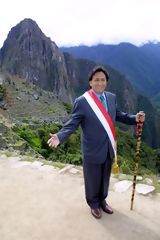In May 2000, Alberto Fujimori Fujimori ran for a third term against his main opponent, Alejandro Toledo, a renowned economist. However, reports of fraud in the first round led Toledo to boycott the second round. Despite this, Fujimori was re-elected and took office on July 28th. Shortly after, compromising video tapes surfaced showing his advisor, Vladimiro Montesinos, bribing congress members. This event plunged the government into turmoil, and international pressure forced Fujimori to announce new elections.
Facing this crisis, Fujimori fled to Japan in November 2000. Valentín Paniagua, the president of Congress, assumed the interim presidency and scheduled new elections for April 2001. These elections saw Alejandro Toledo facing Alan García Perez, the former president from 1985 to 1990, who had been accused of corruption. Toledo secured 36% of the votes, with García receiving 24%. In June 2001, Toledo was elected president, marking the beginning of a new democratic era in Peru.
 Under Toledo's presidency, Peru embraced neoliberal reforms and continued the economic policies established by Fujimori. This period was characterized by relative stability and economic growth driven by expansion in construction, mining, and agriculture. Foreign investments increased, and inflation remained under control. However, social inequalities persisted, and the government faced the challenge of addressing rural poverty.
Under Toledo's presidency, Peru embraced neoliberal reforms and continued the economic policies established by Fujimori. This period was characterized by relative stability and economic growth driven by expansion in construction, mining, and agriculture. Foreign investments increased, and inflation remained under control. However, social inequalities persisted, and the government faced the challenge of addressing rural poverty.
In 2006, Toledo's term ended. The presidential election saw Alan García Perez, once disgraced, return to power with a focus on economic growth and poverty reduction. During his second term, Peru experienced rapid development, with significant reductions in unemployment and poverty. Political stability and economic resilience during the global financial crisis of 2008-2009 further strengthened Peru's position as an emerging power in Latin America.
Capitalizing on global economic growth, García implemented a series of reforms to attract more foreign investment. Growth reached record levels, nearing 9% in 2010. Peru became a regional benchmark for stability in an often crisis-prone region. However, this prosperity did not benefit all social classes equally, and tensions arose between rural communities and the government over natural resources.
In 2011, Toledo ran again, as did Keiko Fujimori, the daughter of the former president. However, it was nationalist candidate Ollanta Humala who won the elections with a majority in the second round. The country was divided between strong economic growth and persistent poverty, especially in rural areas. Humala, promising to reduce inequalities, launched ambitious social programs targeting the most vulnerable populations.
Humala's presidency focused on improving living conditions for the poor. He introduced several social programs, such as Juntos, which supported struggling families, and Pensión 65, aimed at elderly citizens without resources. However, his government faced social unrest, particularly in regions where mining projects were seen as threats to the environment and local livelihoods.
While Peru continued to grow economically, the challenges remained. Inequality persisted, and the country had to navigate between modernization and respect for indigenous traditions. International pressure for sustainable environmental management and resource exploitation increased, as infrastructure demands grew.
Today's Peru is a country in transformation, with a dynamic economy and significant social reforms. However, issues related to corruption, social inequality, and environmental protection remain major obstacles. Despite these challenges, Peru continues to play a key role in Latin America, attracting foreign investment and developing relations with major global economies.
With a growing middle class and increased efforts to fight poverty, Peru appears well-positioned to continue on its path of growth while striving to balance economic development with social justice.